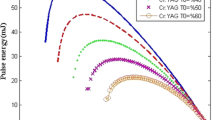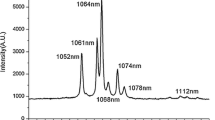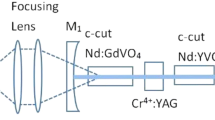Abstract
A passively Q-switched 1.06 μm Nd:GdVO4 laser with a [100]-cut Cr4+:YAG saturable absorber was demonstrated. The output characteristics were investigated when the anisotropic transmission of Cr4+:YAG crystal and the incident pump power level were considered. The experimental results showed that it was feasible to generate laser with narrower pulse width (τ p ), higher pulse energy and peak power when the polarization direction of laser was parallel to the [001], [010], [\(00\overline{1}\)], and [\(0\overline{1}0\)] orientations of the Cr4+:YAG crystal. The different changes of τ p as a function of incident pump power was observed due to the anisotropy of transmission of Cr4+:YAG and the different gain levels (pump power levels). If the Cr4+:YAG was fully bleached as a result of high cavity gain or due to the laser polarization direction was parallel to the [001], [010], [\(00\overline{1}\)], and [\(0\overline{1}0\)] orientations, τ p was constant, otherwise τ p decreased when the gain increased.
Similar content being viewed by others
Avoid common mistakes on your manuscript.
1 Introduction
Q-switched lasers are used in many applications, such as laser lidar, remote sensing, micro-machining, and microsurgery [1, 2]. Compared with active Q-switching, the passive techniques have advantages such as lower cost, compactness, simplicity in set-up, and operation since they do not require external control. Cr4+:YAG crystal as a saturable absorber has advantages of improved thermo-mechanical properties, large absorption cross section, low saturable intensity, and high damage threshold [3, 4].
The output performance, such as output energy, E p , pulse duration, τ p , pulse peak power, P p , and pulse repetition rate, f, are important for passively Q-switched lasers. Many theoretical models and experimental results about passively Q-switched lasers have appeared in the literature [5–12]. But some of the theoretical opinions and experimental observations differed in these publications. For example, Degnan [5] reported that τ p was not affected by the pump power level, but was determined by other parameters, such as the cavity length. This was confirmed by experimental results reported in [6–8]. However, Lu et al. [9] reported that τ p decreases when the incident pump power increases, which was supported by experimental investigations [10–12]. In our characterization studies of a Cr4+:YAG passively Q-switched Nd:GdVO4 laser, both these two different experimental phenomenon were observed for the first time in the same experimental configuration, which we attributed them to the anisotropy of the Cr4+:YAG transmission and the different laser cavity gain. The anisotropic transmission of Cr4+:YAG crystal was previously reported in [13, 14], but to the best of our knowledge, there was no researcher to report the above two changes of τ p simultaneously, not to mention giving an explanation.
In this paper, we demonstrated a passively Q-switched 1.06 μm Nd:GdVO4 laser with a [100]-cut Cr4+:YAG crystal by 808 nm laser diode pumping. The output characteristics were investigated when the anisotropic transmission of Cr4+:YAG crystal and the different gain levels were considered. The experimental results showed that we could obtain a pulsed laser output with narrower τ p , higher E p and P p when the polarization direction of laser was parallel to the [001], [010], [\(00\overline{1}\)], and [\(0\overline{1}0\)] orientations of the Cr4+:YAG crystal, respectively. The different changes of τ p as a function of incident pump power were observed due to the anisotropic transmission of Cr4+:YAG crystal and the different cavity gain levels.
2 Experimental setup
The experimental configurations of a [100]-cut Cr4+:YAG passively Q-switched Nd:GdVO4 laser using 808 nm laser-diode end-pumping is shown in Fig. 1.
The 808 nm pump source was a fiber coupled laser diode. L1 and L2 were a set of collimating and focusing lenses. The a-cut Nd:GdVO4 crystal with a 0.3 at.% Nd3+ concentration had dimensions of 3×3×8 mm3. The crystal was wrapped with indium foil and placed into water-cooled copper heat sink. The input mirror M1 was a flat mirror with an antireflection coating at 808 nm and a high reflectivity at 1063 nm. The output coupler M2 had a transmission of 30 % at 1063 nm. The [100]-cut Cr4+:YAG crystal with initial transmission T 0 of 90 % acted as a saturable absorber. The cavity length was about 160 mm.
3 Experimental results and discussions
The dependence of energy transmission T i of the Cr4+:YAG crystal with the angle between the crystallographic axis and the polarization direction of laser was investigated firstly. The crystal was excited with a linearly polarized, AO Q-switched 1063 nm Nd:GdVO4 laser propagating along its growth direction. The schematic of crystallographic axis of Cr4+:YAG, polarized laser and rotation angle β is same as shown in Fig. 1. The laser was focused by a lens to increase the power density I L . The crystal was fixed on a precise rotatable mount in order to measure the rotation dependent T i . The experimental results are shown in Fig. 2.
From Fig. 2, we can see that at a power density of I L =4×105 W/cm2, there is an obvious anisotropic energy transmission. T i varied with the angle β, and the almost same T i peaks appeared every 90∘. When β was 0∘, 90∘, 180∘, and 270∘, the polarization direction of laser was parallel to the [001], [010], [\(00\overline{1}\)], and [\(0\overline{1}0\)] orientations of Cr4+:YAG, respectively, and T i had the maximum value. When the polarization direction of laser was parallel to the [011], [\(01\overline{1}\)], [\(0\overline{1}\overline{1}\)], [\(0\overline{1}1\)], orientations (β=45∘, 135∘, 225∘, and 275∘, respectively), T i was minimum.
The output characteristics of passively Q-switched Nd:GdVO4 laser with the [100]-cut Cr4+:YAG crystal were investigated. The experimental configuration is shown in Fig. 1. The incident pump power was 7.5 W and the Cr4+:YAG crystal was rotated in a full 360∘. The measured results are shown in Figs. 3–7.
From Fig. 3, we can see that the maximum average output power was obtained when β was 0∘, 90∘, 180∘, and 270∘, respectively. This is because of when the polarization direction of laser was parallel to the [001], [010], [\(00\overline{1}\)], and [\(0\overline{1}0\)] orientations, the T i of Cr4+:YAG crystal had a maximum value. The loss was smaller and the laser was easier to oscillate compared with the directions of [011], [\(01\overline{1}\)], [\(0\overline{1}\overline{1}\)], and [\(0\overline{1}1\)].
The modulation depth Q o of Cr4+:YAG crystal is approximately directly proportional to the difference of T i and T 0. Q o peaks emerged when β was 0∘, 90∘, 180∘, and 270∘, respectively. Therefore, at these β values, the repetition rate and the pulse width were at a minimum and the pulse energy and the pulse peak power were maximum, as shown in Figs. 4, 5, 6 and 7.
There are four sinusoidal modulations of T i in a full 360∘. We studied the pulse width as a function of incident pump power at different rotation degree within 45∘ to illustrate the law of the full 360∘. The measured results are depicted in Fig. 8.
From Fig. 8, we can see that at the same incident pump power, the narrowest τ p was achieved when β was 0∘ and the largest could be obtained when β was 45∘. Due to the anisotropic transmission, at β of 0∘ and in the investigated pump power range (from 7.5 W to 13.7 W), the Cr4+:YAG crystal was fully bleached, and the pulse width was constant and ∼76 ns. At other angles (β=10∘, 22.5∘, 35∘, and 45∘, respectively), τ p was a decreasing function of the incident pump power, and it would decrease to a constant value of 76 ns (β=0∘) when the incident pump power increased. Because the gain of the laser oscillator is a function of the incident pump power level, as shown in Fig. 8, the gain impacts the pulse duration. If the Cr4+:YAG was fully bleached as the result of high gain or due to the laser polarization direction was parallel to the [001], [010], [\(00\overline{1}\)], and [\(0\overline{1}0\)] orientations, τ p was constant, otherwise τ p decreased when the gain increased.
4 Conclusions
In conclusion, we have demonstrated a passively Q-switched 1.06 μm Nd:GdVO4 laser with a [100]-cut Cr4+:YAG saturable absorber by 808 nm laser diode pumping. The output characteristics were investigated when the anisotropic transmission of Cr4+:YAG crystal and the different gain levels were considered. The experimental results showed that a pulsed laser output with narrower τ p , higher E p and P p can be achieved when the laser polarization direction was parallel to the [001], [010], [\(00\overline{1}\)], and [\(0\overline{1}0\)] orientations of Cr4+:YAG, respectively. Two different effects of constant τ p and varying τ p were observed due to the anisotropy of transmission of Cr4+:YAG crystal and the gain level. If the Cr4+:YAG was fully bleached as the result of high gain or due to the laser polarization direction was parallel to the [001], [010], [\(00\overline{1}\)], and [\(0\overline{1}0\)] orientations of Cr4+:YAG, which was more easily to be complete bleached, τ p was constant, otherwise τ p decreased when the gain increased.
References
H.-H. Wu, S.-F. Chen, C.-H. Cheng, J. Opt. A, Pure Appl. Opt. 9, 376 (2007)
Y. Ma, Y. Zhang, X. Yu, X. Li, F. Chen, R. Yan, Opt. Commun. 284, 2569 (2011)
J. Liu, C. Wang, S. Liu, W. Tian, L. Li, S. Liu, M. Liu, J. Mod. Opt. 55, 1971 (2008)
Y. Ma, X. Yu, X. Li, R. Fan, J. Yu, Appl. Opt. 50, 3854 (2011)
J.J. Degnan, IEEE J. Quantum Electron. 31, 1890 (1995)
F.Q. Liu, H.R. Xia, S.D. Pan, W.L. Gao, D.G. Ran, S.Q. Sun, Z.C. Ling, H.J. Zhang, S.R. Zhao, J.Y. Wang, Opt. Laser Technol. 39, 1449 (2007)
G. Xiao, M. Bass, IEEE J. Quantum Electron. 33, 41 (1997)
M. Montes, C. delas Heras, D. Jaque, Opt. Mater. 28, 408 (2006)
M. Lu, C.R. Chatwin, R.C.D. Young, P.M. Birch, Opt. Lasers Eng. 47, 617 (2009)
J. Liu, J. Yang, J. He, Opt. Laser Technol. 35, 4314 (2003)
C. Du, J. Liu, Z. Wang, G. Xu, X. Xu, K. Fu, X. Meng, Z. Shao, Opt. Laser Technol. 34, 699 (2002)
Y.F. Ma, R.W. Fan, X. Yu, X.D. Li, D.Y. Chen, J.H. Yu, Laser Phys. 21, 1570 (2011)
H. Eilers, K.R. Hoffman, W.M. Dennis, S.M. Jacobsen, W.M. Yen, Appl. Phys. Lett. 61, 2958 (1992)
X. Zhang, S. Zhao, Q. Wang, S. Zhang, L. Sun, X. Liu, S. Zhang, H. Chen, J. Opt. Soc. Am. B 18, 770 (2001)
Author information
Authors and Affiliations
Corresponding author
Rights and permissions
About this article
Cite this article
Ma, Y.F., Yu, X., Tittel, F.K. et al. Output properties of diode-pumped passively Q-switched 1.06 μm Nd:GdVO4 laser using a [100]-cut Cr4+:YAG crystal. Appl. Phys. B 107, 339–342 (2012). https://doi.org/10.1007/s00340-012-4973-1
Received:
Published:
Issue Date:
DOI: https://doi.org/10.1007/s00340-012-4973-1












